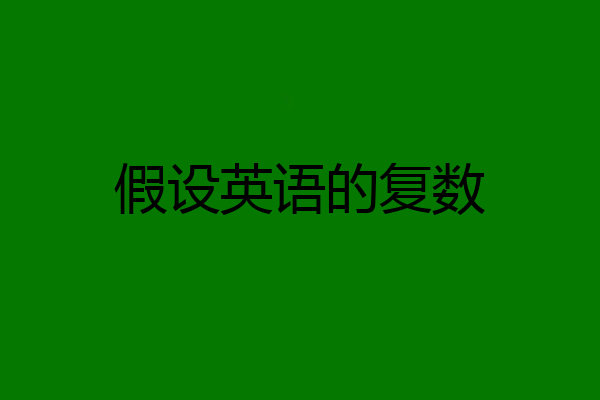
贪吃的双鱼宝宝
复数只名词的复数形式。汉语不区分,而英语是要区分的,主要区别在于可数名词中。如汉语中一本书和一些书,都是书这个名词。而英语则不然。一本书是abook,一些书是somebooks此时books就是book的复数形式。不可数名词,顾名思义,是不可数的。单数形式和复数形式相同。如一杯水和十杯水,acupofwater和tencupsofwater,此例中,水不可数,需要用容器杯子来衡量多少,而杯子可数,故cups是cup的复数形式,而water无论单数复数皆为water。形物指形容词性物主代词,如我的,my,这个词要看成是形容词,就是不能直接做主语,宾语,必须修饰名词,也就是和名词连用才可以成为一个完整的句子成分。如我的笔,mypen,我的杯子,mycup,我的奶酪mycheese,谁动了我的奶酪,Whotouchedmycheese?等等,必须与名词连用。名物指名词性物主代词,即可以直接作为名词使用的,在句子中直接充当成分的。如我的:mine,你的,yours等等。在句子中,比如,这个东西是我的。thisismine.此时,不能用my,因为,my要和名词连用,用my的话,须变为thisismything(可以具体到杯子,书,等等).而mine只是在该对话中,代指上文所涉及的某件物品,或者是我的物品。关于复数,形物,名物的具体详细描述和更多实例,楼主可以去翻翻语法词典。里面的内容应该比较适合您。


ID换了又换
.以不可数名词结尾的复合名词无复数形式。如:homework,newspaper等。2.以man或woman为前缀的名词变复数时,前后两个名词都变成复数。如:womandoctor→womendoctors,manwaiter→menwaiters。3.以两个名词构成的复合名词(前面的名词为man或woman除外),一般把后面的名词变复数。如:boyfriend→boyfriends,paperbag→paperbags。4.以“可数名词+介词(短语)”构成的复合名词变复数时,把前面名词变复数。如:father-in-law→fathers-in-law。5.以“动词/过去分词+副词”构成的复合名词变复数时,在词尾加s。如:grown-up→grown-ups,stand-by→stand-bys。6以“man”"woman"等构成的复数名词,两个都要变复数mandoctor→mendoctorswomanteacher→womenteachers【有不会的可以再问我】

Lucky小钰
1.英语名词一般都是单数形式,在名词尾巴上+S后,名词就变成了复数形式.school-schools,book-books.brother-brothers.2,以S,X,CH,SH,等结尾的单词变成复数时,需加es.如:class-classes,dish-dishes,church-churches,box-boxes,watch-watches,brush-brushes,match-matches.(这些单词变成+S是为什么要变成ES那,

wangxinrose
常用的以O结尾变复数时加es的单词不多,怎才能把它们和其他的词区别开呢你只要几住三个就行了,它们就是“hero”、“tomato”、“potato”.很简单,“英雄爱吃番茄和土豆”!其他的英雄都不喜欢吃。那三样东西是英雄喜欢的,要特殊对待,加es,所以呢,其他的通通只加s.会区分了吧!

锐客家族
英语名词单数变复数主要有以下规则: 一、绝大多数的可数名词的复数形式,是在该词末尾加上后辍-s。 读音变化:结尾是清辅音读[s],结尾是浊辅音或元音读[z]。 例:friend→friends; cat→cats; style→styles; sport→sports; piece→pieces 二、凡是以s、z、x、ch、sh结尾的词,在该词末尾加上后辍-es构成复数。 读音变化:统一加读[iz]。 例:bus→buses; quiz→quizzes; fox→foxes; match→matches; flash→flashes box →boxes; watch →watches; actress →actresses; class →classes; coach(长途车) →coaches; dress →dresses; sandwich →sandwiches; toothbrush →toothbrushes; waitress(女侍者) →waitresses 三、以辅音字母+y结尾的名词,将y改变为i,再加-es。 读音变化:加读[z]。 例:candy→candies; daisy(雏菊)→daisies; fairy→fairies; lady→ladies; story→stories strawberry →strawberries; baby →babies; puppy →puppies; library →libraries; dictionary →dictionaries; cherry →cherries; activity →activities 四、以-o结尾的名词,如果不是外来词或缩写,就加-es,否则加-s构成复数。 (有生命的加es,无生命的加s) 读音变化:加读[z]。 例:tomato→tomatoes; potato→potatoes; torpedo(鱼雷)→torpedoes; bingo(彩票式游戏)→bingoes 反例:silo(青贮塔)→silos; piano→pianos(外来词); photo→photos; macro(宏指令,计机算语言)→macros(缩写词) 五、以-f或-fe结尾的名词,多为将-f或-fe改变为-ves,但有例外。 读音变化:尾音[f]改读[vz]。 例:knife→knives; life→lives; leaf→leaves; staff(员工)→staves; scarf(围巾)→scarves 目前搜集的直接加s:roof-roofs, belief-beliefs,gulf(海湾)-gulfs, serf(农奴)-serfs, safe-safes,chief(负责人)-chiefs 这几个可变可不变: scarf-scarfs,handkerchief- handkerchiefs 六、以-us结尾的名词(多为外来词),通常将-us改变为-i构成复数。 读音变化:尾音[Es]改读[ai],其中[kEs]要改读为[sai],[gEs]要改读为[dVai]。 例:fungus(真菌)→fungi; abacus(算盘)→abaci; focus(焦点)→foci; cactus(仙人掌)→cacti; cestus(拳击用的牛皮手套)→cesti 七、以-is结尾的名词,通常将-is改变为-es。 读音变化:尾音[is]改读[i:z]。 例:axis(轴线)→axes; basis→bases; naris(鼻孔)→nares; hypothesis(假设)→hypotheses; restis(索状体)→restes 八、以-ix结尾的名词,通常将-ix改变为-ices,但有例外。 读音变化:尾音[iks]改读[isi:z]。 例:matrix(矩阵)→matrices; directrix(准线)→directrices; calix(杯状窝,盏)→calices; appendix(阑尾)→appendices 反例:affix(粘住,使固定)→affixes 九、以-um结尾的名词,将-um改变为-a。 读音变化:去掉鼻尾音[m]。 例:forum(论坛)→fora; stadium(体育场)→stadia; aquarium(水族鱼缸)→aquaria; datum(数据)→data; vacuum(真空,空虚)→vacua 十、以-a结尾的名词,在该词末尾加上后辍-e。 读音变化:尾音[E]改读[i:]。 例:larva(昆虫的幼虫)→larvae; formula(公式)→formulae; ala(翼)→alae; media(媒介)→mediae; hydra(九头蛇,水螅)→hydrae 十一、部分单词的复数形式不变。 读音变化:保持原音。 例:fish→fish; sheep→sheep; cattle→cattle; deer→deer; salmon(蛙、三文鱼、大马哈)→salmon cannon →cannon; trout →trout(鳟鱼) 十二、极少数单词,其复数形式没有任何规律。 读音变化:没有规律。 例:man→men; woman→women; child→children; person→people; ox→oxen foot →feet; goose →geese; mouse →mice; tooth →teeth; datum →data数据 十三、一些单数词得加en才能变成复数词: 例:ox→oxen; child→children; brother(用于教堂)→brethren 十四、一些单数词得改头换面一番,才能变成复数词 例:analysis→analyses分析; basis→bases基础; datum→data数据; foot→feet; formula公式→formulae/formulas; goose→geese; louse虱子→lice; man→men mouse→mice; medium→media/mediums媒介; emorandum→memoranda/memorandums备忘录; parenthesis→parentheses 圆括号; phenomenon→phenomena现象; radius→radii 半径 tooth→teeth; woman→women 十五、有些名词是单数、复数不分的 例:deer; fish; cannon(大炮); sheep; salmon 鲑鱼; trout 鳟鱼 十六、一些名词虽分单数、复数,但出现次数多的总是单数词 例:absence; clothing;film; help; furniture家具; machinery机械; news; scenery风景; sugar; traffic交通 十七、另一些名词则以复数词出现的机会较多 例:bellows风箱; clothes; police; shorts短裤; scissors剪刀; spectacles眼镜; shears大剪刀 trousers长裤; wages工资 十八、compound nouns,这类复数词是以主要的名词来表示 例:daughter-in-law→daughters-in-law 媳妇; father-in-law→fathers-in-law岳父 man-of-war→men-of-war兵舰; maid-servant→maid-servants 女仆tep-son→step-sons晚子; son-in-law→sons-in-law 女婿 十九、若表达具体数目,要借助数量词 例:pair(对,双); suit(套); a pair of glasses; two pairs of trousers 二十、另外还有一些名词,其复数形式有时可表示特别意思, 例:goods货物,waters水域,fishes(各种)鱼 二十一、除人民币元、角、分外,美元、英镑、法郎等都有复数形式。 例:a dollar, two dollars; a meter, two meters 二十二、合成词单复数变化规则 1)以不可数名词结尾的复合名词无复数形式。例如:homework, newspaper等。 2)以man或woman为前缀的名词变复数时,前后两个名词都变成复数。例如:woman doctor→women doctors, man waiter→men waiters. 3)以“可数名词+介词(短语)”构成的复合名词变复数时,把名词变复数。例如:fath -erinlaw→fathersinlaw. 4)以“动词/过去分词+副词”构成的复合名词变复数时,在词尾加s。例如:grownup→ grownups, standby→standbys. 二十三、集合名词单复数变化 有些名词为单数形式,但做整体概念来看待,称为集合名词或集体名词,如:people police cattle,其谓语动词一般用复数。有些名词为单数形式,做整体概念来看待时,谓语动词用单数。强调整体中具体人或事物时,谓语动词用复数。如:class, family, audience, committee, army.【例句】 1) The class are doing experiments on heat and light in the lab. 2) A large class is like a big banquet, which requires a teacher to make full pr eparation and have good performance. 集体名词,以单数形式出现,但实为复数。例如: peoplepolicecattle 等本身就是复数,不能说 a people,a police,a cattle,但可以说a person,a policeman,a head of cattle, the English,the British,the French,the Chinese,the Japanese,the Swiss 等名词,表示国民总称时,作复数用,如The Chinese are industries and brave.中国人民是勤劳勇敢的。二十四. 不同国籍人的单复数 国籍 总称(谓语用复数) 单数 复数 中国人 the Chinese a Chinese two Chinese 瑞士人 the Swiss a Swiss two Swiss 澳大利亚人the Australians an Australian two Australians 俄国人 the Russians a Russian two Russians 意大利人 the Italians an Italian two Italians 希腊人 the Greek a Greek two Greeks 法国人 the French a Frenchman two Frenchmen 日本人 the Japanese a Japanese two Japanese 美国人 the Americans an American two Americans 印度人 the Indians an Indian two Indians 加拿大人 the Canadians a Canadian two Canadians 德国人 the Germans a Germans two Germans 英国人 the English an Englishman two Englishmen 瑞典人 the Swedish a Swede two Swedes 希望帮到你